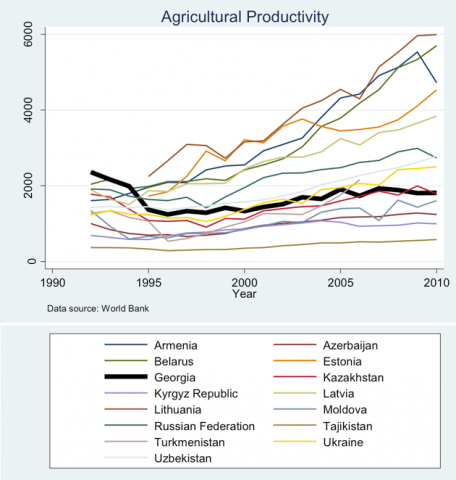 15
November
2021
15
November
2021
ISET Economist Blog
 Thursday,
11
October,
2012
Thursday,
11
October,
2012

 Thursday,
11
October,
2012
Thursday,
11
October,
2012
While more than half of all jobs in Georgia are in the agricultural sector, agriculture’s share of value-added to GDP was only 11 percent in 2007 (World Bank). And although Georgia was a major producer of food, wine, tea, and mineral water during Soviet times, most of the food products on the shelves today are imported from abroad (FAO).
Yet what is even more remarkable is that Georgia seems to be the only former Soviet republic in which agricultural productivity hasn’t returned to or exceeded its level in 1992. As of 2010, agricultural productivity stood at only 77 percent of where it was nearly two decades ago.
The graphs below illustrate the puzzle of agricultural productivity in Georgia. The first graph is of agriculture value added per agricultural worker in constant 2000 US dollars (the data come from the World Bank). The second graph is of agricultural productivity relative to its level in 1992, multiplied by 100. If this index equals 100, for instance, this means agricultural productivity during a particular year was exactly the same as it was in 1992. If the index equals 200, this means agricultural productivity has doubled since 1992, and so on.


Note that Estonia and Lithuania are absent from the second graph due to missing data from 1992 to 1994. Nevertheless, it is clear from the figures in the first graph that Estonia and Lithuania have experienced tremendous growth in agricultural productivity over the past two decades.
While agricultural productivity is currently much lower in Tajikistan or the Kyrgyz Republic, Georgia appears to stand alone in terms of never recovering to its previous level of agricultural productivity.
So, the question remains: why hasn’t agricultural productivity improved in Georgia over the past two decades, while it has at least recovered in every other former Soviet republic? It is even more puzzling to consider why agricultural productivity has grown by nearly 200 percent in Armenia since 1992, while it has declined in Georgia since then. These are certainly interesting questions for future research.





